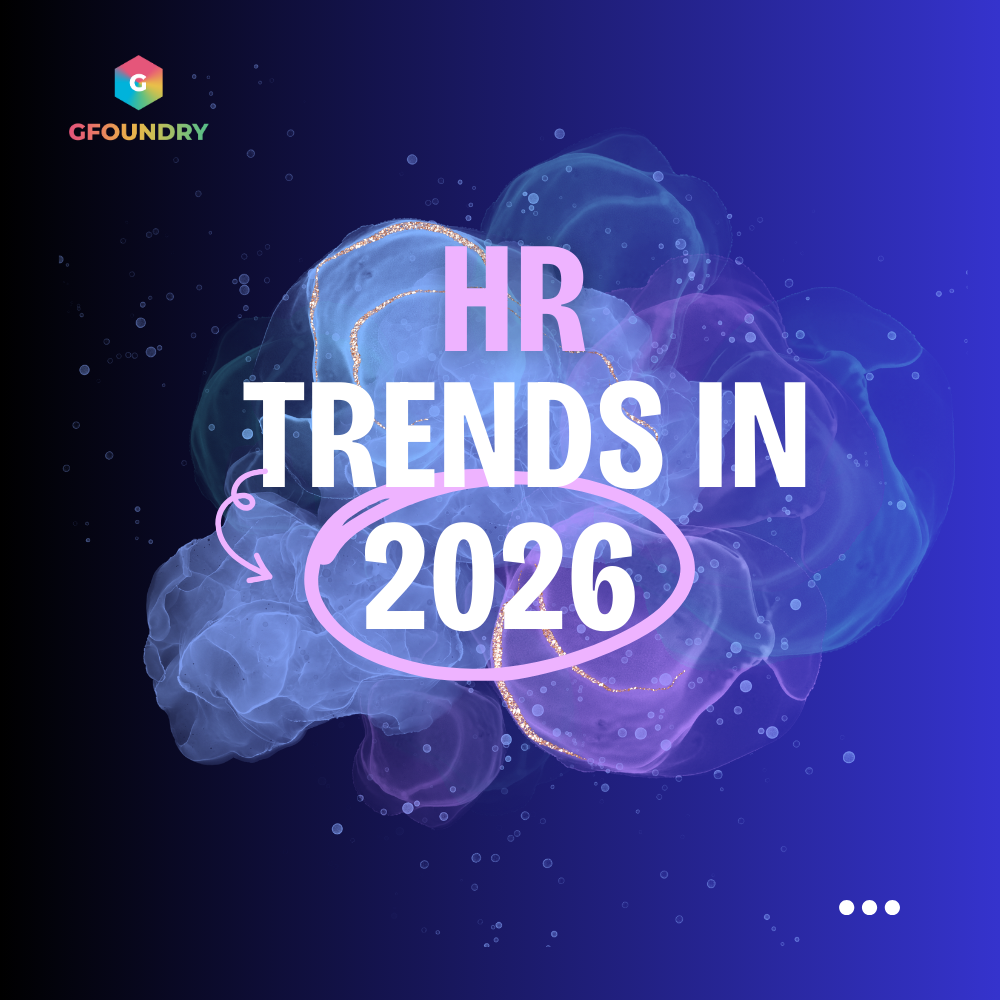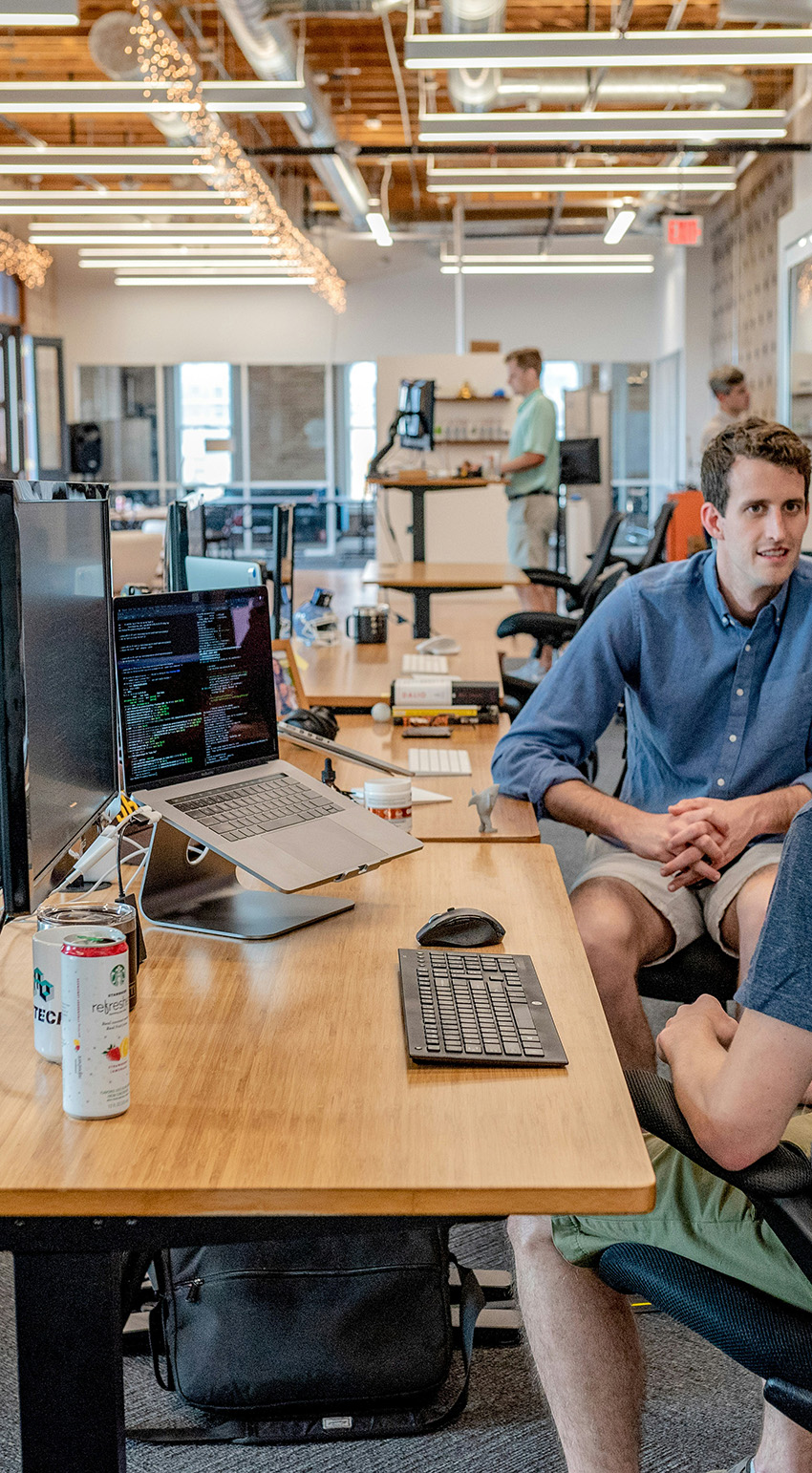 The Future of Human Resources: Defining the 2026 Landscape
The Future of Human Resources: Defining the 2026 Landscape
In the swiftly evolving realm of business, 2026 stands as a year poised for transformative shifts, especially within the domain of Human Resources and the broader HR Strategy 2026.
Drawing from the wellspring of knowledge shared by leading institutions and thought leaders, this comprehensive article amalgamates the most pivotal HR trends poised to shape the year ahead.
From reimagined work cultures that prioritize human well-being and organizational plasticity to the intertwining of technology and HR practices, these insights are not just projections but a roadmap to navigate the future.
Our synthesis covers six pivotal themes:
Each theme, further dissected into specific trends, encapsulates the collective wisdom and research from esteemed sources including Forbes, Gartner, Deloitte, McKinsey, PwC, Research Gate, Harvard Business Review, and the Society for Human Resource Management.As we stand on the brink of this new era, it is more crucial than ever for HR professionals and leaders to stay abreast of these shifts. This article is not just an observation of the current HR landscape, but an essential guide for those aiming to lead their organizations with foresight and adaptability.
Whether you’re an HR executive, a business leader, or an employee seeking to understand the future of the workplace, this piece serves as the definitive reference point. Engage with it, reflect on its insights, and let it inform your strategic decisions for 2026 and beyond.
 1. Work Culture and Environment
1. Work Culture and Environment
1.1 Human-centric Culture: Shaping the Future of HR
At the heart of every successful business is its people. As organizations navigate the complexities of a rapidly changing world, there’s a distinct shift towards a human-centric culture. This approach prioritizes employees’ well-being, growth, and sense of belonging, acknowledging that an empowered and satisfied workforce can be a significant driver of business success. Harvard Business Review has emphasized the benefits of such a culture, noting increased employee engagement and productivity.
Why is this a prevailing trend? Simple. In the age of automation and digital transformation, the irreplaceable value of human creativity, empathy, and collaboration has become even more pronounced. Companies recognizing this are investing in a culture that values these human elements, ensuring not only the company’s growth but also fostering a workspace where individuals feel genuinely valued and motivated.
What are the Benefits of a Human-centric Culture?
Embracing a human-centric approach leads to a multitude of advantages for businesses. It promotes employee engagement, fosters innovation, and leads to higher retention rates. Organizations that prioritize their employees’ well-being witness a boost in morale and motivation, directly impacting productivity and the bottom line. Gallup has consistently found that companies with higher employee engagement levels are more profitable.
1.2 A Focus on Total Wellbeing
Total wellbeing encompasses physical, mental, emotional, social, and financial health. By supporting employees’ wellbeing in all of these areas, organizations can improve productivity, reduce absenteeism, and boost employee morale.
By taking a holistic approach to employee wellbeing, organizations can create a more productive, engaged, and happy workforce.
Here are some additional resources on the topic of total wellbeing:
- The Wellbeing Index (Gallup)
- A Total Well-Being Approach: Why it’s Essential in Turbulent Times (AIHR)
1.3 Creating Purpose-Driven Organizations
In the evolving landscape of HR, one trend that stands out is the emergence of purpose-driven organizations. These organizations not only aim for profit but also focus on having a positive societal impact. They align their business strategies with a higher purpose that transcends the traditional objectives. The idea is to create a meaningful workplace, where employees feel their work has a larger significance beyond just earning a paycheck.
Why Creating Purpose-Driven Organizations is this a trend?
As we delve deeper into the 21st century, it’s becoming clear that employees, especially millennials and Gen Z, are not only looking for monetary compensation from their jobs but also seeking meaning and fulfillment. A Deloitte survey found that “organizations with a strong sense of purpose are more confident in their growth prospects.” Such organizations tend to have more engaged employees, attract top talent, and often report better financial performance. Additionally, consumers are becoming more socially conscious and prefer doing business with companies that prioritize social responsibility. Hence, the shift towards becoming a purpose-driven organization is not just about employee satisfaction but also about gaining a competitive edge.
1.4 Pay, Culture, Flexibility, and Meaningful Work
As the modern workforce evolves, a new HR trend is taking center stage: the convergence of pay, culture, flexibility, and meaningful work. No longer isolated elements, these factors collectively shape employee satisfaction, productivity, and loyalty. The modern worker is not solely driven by financial incentives; they seek a holistic employment experience that aligns with their values and aspirations. This shift reflects a broader societal recognition that our jobs can, and should, provide more than just a paycheck.
Why is this a trend? As Millennials and Gen Z enter and influence the workforce, their preferences and values come into play. Multiple surveys have shown that these generations prioritize work-life balance, organizational culture, and the purpose behind their tasks over traditional metrics like salary. As organizations adapt to these preferences, integrating pay, culture, flexibility, and meaningful work becomes a strategic necessity rather than a choice.
 1.5 Employee Experience in HR
1.5 Employee Experience in HR
What is Employee Experience?
Employee Experience is a holistic approach that encompasses every interaction an employee has with their organization. It stretches beyond mere job responsibilities and encompasses the culture, tools, and spaces (both physical and digital) provided to employees. The goal? To create a cohesive and positive experience that motivates, engages, and retains.
Harvard Business Review emphasizes how businesses investing in EX have witnessed lower attrition rates and better financial performance.
In recent years, the concept of Employee Experience (EX) has rapidly emerged as a pivotal factor in HR practices. More than just employee engagement or satisfaction, EX delves into the holistic journey of an employee within an organization – from recruitment, onboarding, professional development, to eventual offboarding. This shift signifies a deeper recognition by companies that every touchpoint matters in retaining top talent and ensuring optimal productivity.
Why is Employee Experience (EX) a trend?
Employee Experience (EX) is a trend because employees are now more than ever in search of roles that provide value, meaning, and align with their personal and professional goals. With the surge of remote work and the emergence of a global workforce, ensuring a positive employee experience becomes a key differentiator in talent acquisition and retention. Companies that prioritize EX are likely to witness improved morale, higher retention rates, and overall better business outcomes.
1.6 The Gen X Leadership Effect
As Baby Boomers increasingly retire, Generation X (born between 1965 and 1980) is stepping up to fill leadership roles across numerous industries. Unlike their predecessors, Gen X leaders blend the traditional leadership styles with an inherent understanding of technological advancements, valuing both experience and innovation. This unique combination has ushered in a more agile, tech-savvy, and holistic approach to leadership, propelling businesses into the future with adaptability and foresight.
With the rise of digital transformation, the Gen X leadership approach promotes a balanced view, understanding the need for digital tools while appreciating the human touch. Their experience in both pre-internet and digital-native eras gives them a unique advantage in leading cross-generational teams, driving both modernization and cohesion in the workplace.
1.7 HR Burnout Is A Crisis That Needs To Be Addressed
In recent years, HR professionals have faced mounting pressures and demands, leading to a rising trend of HR burnout. Burnout in HR is not merely about individual fatigue; it affects the efficiency of entire organizations and can hinder talent retention and acquisition. As companies grow, so do their human resource needs, making it imperative for businesses to recognize and address HR burnout urgently.
The surge in remote work, as highlighted by Gallup, and the increased responsibilities regarding employee well-being and mental health have only amplified the challenges faced by HR professionals. This trend is a reflection of the broader shifts in the workplace and calls for immediate interventions.
Why HR Burnout Is Becoming A Crisis
HR departments are at the epicenter of evolving workplace dynamics. From managing remote teams to addressing heightened employee anxieties, the pandemic has thrust HR into uncharted territories. Harvard Business Review underscores the importance of preventing staff burnout, and this is especially pertinent for HR professionals who are the first line of defense for employee well-being.
1.8 Support Managers and Leaders
Companies are recognizing the importance of supporting their managers and leaders. This means providing them with resources, tools, and training to manage teams effectively. As businesses face unprecedented challenges, having strong and resilient leadership becomes crucial. Supporting leaders isn’t just about ensuring operational success; it’s about building sustainable and adaptable organizations.
1.9 Upskilling Leaders and Managers
Upskilling leaders and managers is becoming a priority. With the rapid pace of technological change, managers need to be equipped with the latest skills and knowledge. This trend is driven by the realization that for companies to stay competitive, their leadership must be equipped with multidisciplinary knowledge and the ability to drive digital transformation.
1.10 Optimising Organisational Plasticity
Organisational plasticity refers to a company’s ability to adapt and reconfigure its structure and operations in response to external changes. As the market dynamics shift, companies that can restructure rapidly and effectively will thrive. This trend underscores the importance of flexible strategies and an agile workforce in today’s volatile business environment. Read our article “Building Resilient and Adaptive Workforces: A Global Talent Trends Study”.
1.11 Greater Emphasis Placed on Mental Health
Employee well-being has always been crucial, but now, there’s an intensified focus on mental health. Companies are incorporating wellness programs, flexible work schedules, and resources to ensure their employees are mentally sound. This trend is not just about altruism; healthy employees are more productive, engaged, and contribute positively to the company culture.
Read more here: Three Research-Backed Benefits of Mindfulness at Work
1.12 Employee Benefit Trends that are expected to take shape in 2026
As we look ahead to 2026, there are several Employee Benefit Trends that are expected to take shape and influence the way employers support their workforce.
The table below provides an overview of these emerging trends, categorized into five main areas: Personalized Benefits, Wellness Benefits, Financial Wellness Benefits, Family-Friendly Benefits, and Sustainability Benefits. Each category highlights specific examples of benefits, such as healthcare plans, on-site fitness centers, tuition reimbursement, paid parental leave, and carbon offsetting.
These benefits reflect the evolving needs and preferences of employees, aiming to attract and retain top talent, promote well-being, and support various personal and environmental goals.
| Benefit Category | Description |
|---|---|
| Personalized benefits |
|
| Wellness benefits |
|
| Financial wellness benefits |
|
| Family-friendly benefits |
|
| Sustainability benefits |
|
Related articles:
 2. Work Modalities and Office Dynamics
2. Work Modalities and Office Dynamics
2.1 Phygital Will Be the New Normal
‘Phygital’ blends the physical and digital experiences, offering an integrated approach to HR processes. This trend acknowledges that while digital transformation is revolutionizing HR, the human touch remains essential. Thus, phygital solutions are emerging, enabling organizations to combine the best of both worlds to enhance employee experience.
The adoption of phygital is not just about incorporating digital tools; it’s about seamlessly blending technology with physical human interactions. As businesses strive for digital adaptability, the phygital approach is increasingly becoming the new normal in HR.
2.1.1 The Rise of the Phygital Experience
In today’s fast-paced business environment, the line between physical and digital experiences is increasingly blurring. The fusion of these two realms has given birth to what we now call the “Phygital Experience” in human resources. This section delves into why this evolution seems inevitable and explores the market trends that are driving this shift.
2.2.2 The “Phygital” Experience: An Inevitable Evolution?
The term ‘Phygital’ is a blend of ‘physical’ and ‘digital,’ encapsulating an integrated experience where one complements the other. In the realm of HR, this experience is not just a buzzword but an essential aspect of modern talent management. The COVID-19 pandemic, the rise of remote work, and the need for real-time collaboration have accelerated the integration of physical and digital work environments. As businesses strive for agility, resilience, and employee engagement, adopting a phygital approach seems less like an option and more like a necessity.
| Aspect | Physical Experience | Digital Experience | Phygital Experience |
|---|---|---|---|
| Collaboration | Limited to office space | Global but lacks human touch | Global and enriched by physical cues |
| Flexibility | Low | High | Optimal |
| Employee Engagement | High in short term | May diminish over time | Sustainable and balanced |
| Accessibility | Limited to on-site resources | Anytime, anywhere but may lack depth | Comprehensive and ubiquitous |
| Productivity | Can be high but constrained by location | Location-independent but may lack focus | Optimized through both focus and flexibility |
| Training & Development | Hands-on but limited scalability | Scalable but may lack practicality | Scalable and hands-on |
| Well-being & Mental Health | Immediate support but limited to office hours | 24/7 digital support but may lack empathy | Rounded support with both immediate and digital accessibility |
| Resource Management | Focused on physical assets | Focused on digital assets | Optimized use of both physical and digital assets |
| Communication | Face-to-face but limited reach | Wide reach but may lack nuance | Wide reach with added nuance of face-to-face |
| Data Security | Physical storage & security measures | Digital encryption & cloud storage | Enhanced through combined physical and digital measures |
| Talent Acquisition | On-site interviews and assessments | Remote screening and digital tests | Hybrid approach for a more complete evaluation |
| Innovation & Creativity | Brainstorming sessions in physical space | Collaborative digital tools for idea generation | Fusion of physical and digital for richer brainstorming |
2.2.3 Market Trends Supporting the Shift
The move toward a phygital workplace is not happening in a vacuum; it’s supported by several market trends. The increasing adoption of Internet of Things (IoT) devices, the rise of Artificial Intelligence in HR processes, and the growing demand for a better work-life balance are all contributing factors.
- IoT in the Workplace: From smart badges that track employee movements for optimal workspace utilization to connected coffee machines that can be operated via smartphone, IoT is making the workplace smarter and more interactive.
- AI and Automation: AI-driven chatbots for employee onboarding, automated scheduling tools, and real-time performance analytics are just a few examples of how AI is streamlining HR operations. Gi, GFoundry’s AI assistant, goes a step further by assisting in course creation and providing actionable insights into employee performance and engagement. This not only enhances learning and development but also helps HR teams make data-driven decisions, improving overall workforce management and productivity.
- Work-Life Balance: The pandemic has made it abundantly clear that employees value the flexibility to balance work and personal life. Phygital models offer the best of both worlds, allowing for flexible work arrangements without sacrificing collaborative opportunities.
- Cybersecurity Measures: In a phygital workplace, cybersecurity becomes even more crucial as sensitive data moves between physical and digital realms. Investments in secure cloud storage, end-to-end encryption, and multi-factor authentication are on the rise, ensuring that both physical and digital assets are protected.
- Augmented Reality (AR) and Virtual Reality (VR): The integration of AR and VR technologies in training programs and virtual office environments has gained momentum. These technologies offer immersive experiences that can bridge the gap between remote and on-site work, enhancing collaboration and learning.
- Real-Time Analytics and Feedback: The use of real-time analytics tools for performance tracking and immediate feedback is becoming common. These tools help in making informed decisions quickly and enable a responsive, agile work environment.
- Employee Wellbeing Programs: Organizations are increasingly incorporating digital wellbeing programs that track various health metrics and offer personalized recommendations. These programs often use IoT devices like wearable fitness trackers and are integrated into the company’s broader health and wellness initiatives.
- Gig Economy and Freelance Platforms: The rise of the gig economy has led to a more fluid workforce. Phygital work environments support this trend by allowing organizations to seamlessly integrate freelancers and part-time workers into their existing workflows and communication platforms.
- Blockchain for HR: Blockchain technology is beginning to be used for secure and transparent contract management, payroll, and even background checks. This adds an extra layer of security and efficiency to HR processes.
- Green and Sustainable Workspaces: As organizations aim for sustainability, phygital work environments are designed to be energy-efficient, with smart lighting, heating, and cooling systems that can be controlled digitally to minimize energy use.
 2.2 The Future Of Work Is Flexibility For All Employees
2.2 The Future Of Work Is Flexibility For All Employees
Flexibility in the workplace has become a top priority for employees. The COVID-19 pandemic has only accelerated this demand, with many workers experiencing the benefits of flexible work schedules. Gartner’s HR survey suggests that over 40% of employees would prefer more flexible work options post-pandemic.
More than just a response to external pressures, offering flexibility is now recognized as a key driver for talent retention, productivity, and employee well-being. It’s clear that flexible working arrangements will be foundational in the future work landscape.
2.3 The Future Of The Office Will Be To Bring The Off-Site Vibe On-Site
With the rise of remote work, employees have grown accustomed to the comforts and individuality of their home workspace. Recognizing this, forward-thinking companies are reimagining office spaces to bring the comfort and vibe of off-site locations into the traditional office setting.
This trend goes beyond just open layouts or modern furniture; it’s about creating a holistic environment where employees feel relaxed, inspired, and connected, similar to their favorite off-site work spots. The office of the future will likely resemble a blend between a coworking space, a café, and a home, providing a more hybrid and holistic workspace experience.
2.4 Asynchronous Work
Asynchronous work allows team members to work on tasks without needing real-time interactions. With the rise of global teams and varied time zones, asynchronous communication tools like Slack or Notion have gained prominence. This method not only accommodates employees’ individual schedules but also promotes deep work by reducing constant interruptions.
By fostering an environment where employees can respond when it’s most convenient, organizations can boost productivity, improve work-life balance, and accommodate a diverse and distributed workforce. As more companies adopt this approach, asynchronous work will play a pivotal role in shaping future work dynamics.
2.5 Distributed, Remote, and Hybrid Work Models
The conventional office-centered work model is evolving rapidly. Driven by technology and the need for adaptability, businesses are now exploring distributed, remote, and hybrid models. These frameworks not only cater to the demand for flexibility but also allow companies to tap into a global talent pool.
While remote work offers employees the freedom to work from any location, hybrid models provide a blend of on-site and remote work. As businesses grapple with challenges posed by global crises, shifting demographics, and evolving employee expectations, these adaptive work models offer a sustainable solution for the future.
 3. HR Practices and Transformation
3. HR Practices and Transformation
3.1 People Experience Departments Will Emerge
As businesses recognize the critical role of employee experience in driving performance, a shift from traditional HR to “People Experience Departments” is occurring. This trend highlights a more holistic approach to talent management, focusing on employees’ overall experience rather than just HR processes. These departments aim to understand and improve the touchpoints of an employee’s journey, leading to increased engagement and productivity.
3.2 Skills-Based Hiring Is On The Rise
Companies are increasingly looking beyond traditional credentials, focusing more on actual skills and competencies. This shift to skills-based hiring allows organizations to tap into diverse talent pools and ensure that hires are genuinely capable, reducing training costs and time-to-productivity. Forbes has highlighted its future prominence in recruitment.
3.3 ESG Reporting Will Expand Beyond Compliance To Attract Talent
Environmental, Social, and Governance (ESG) reporting is moving beyond mere compliance. Modern talents prioritize organizations that showcase sustainable and ethical practices. By expanding their ESG reporting, companies are not just meeting regulations but are also attracting forward-thinking talents who value responsibility. More on this trend can be found on McKinsey.
3.4 Human Skills Are The New Hard Skills For The Future Of Work
While technical skills remain important, human skills like emotional intelligence, critical thinking, and collaboration are becoming indispensable in the future of work. As automation and AI take over repetitive tasks, the distinctly human abilities will distinguish top performers. This perspective has been discussed extensively by World Economic Forum.
3.5 Personalised Rewards Schemes
One-size-fits-all reward systems are giving way to personalized schemes tailored to individual preferences and contributions. This approach boosts motivation, as employees feel more valued and understood. It also reflects a company’s commitment to recognizing individuality and unique contributions. More insights can be seen here.
3.6 Inclusion Across The Employee Life Cycle
Inclusion is becoming a focus throughout an employee’s tenure, from recruitment to exit. By ensuring a sense of belonging at every phase, businesses can improve morale, reduce turnover, and drive better performance. This continuous inclusion strategy is a step towards holistic employee well-being and is elaborated upon by Deloitte.
3.7 Diversity, Equity, And Inclusion (DEI)
DEI initiatives are now core to business strategies, not just a HR checkbox. Recognizing the value of diverse perspectives, businesses are committed to creating equitable environments where everyone feels included. The benefits of such an approach, from improved innovation to better decision-making, have been highlighted by BCG.
3.8 Autonomous Management of HR Career Paths
Empowering employees to have more control over their career paths is a rising trend. Through platforms and tools, HR is enabling individuals to shape their growth trajectories, fostering a culture of self-directed learning and development. Such autonomy leads to greater job satisfaction and retention.
3.9 The Evolving Role of the CHRO
Chief Human Resources Officers (CHROs) are no longer limited to traditional HR functions. Their role is expanding to include business strategy, digital transformation, and organizational culture shaping. As people management intertwines with business outcomes, the CHRO’s position becomes pivotal. The HR Observer delves into this evolution.
 4. Technology and HR
4. Technology and HR
4.1 A New Blended Workforce with Humans And Bots
As technology continues to evolve, workplaces are experiencing a paradigm shift. The emergence of bots and AI in professional spaces has led to a blended workforce where humans and bots collaboratively work together. This hybrid approach leverages the strengths of both entities, resulting in optimized operations, improved efficiency, and enhanced user experiences.
Gi, GFoundry’s AI assistant, exemplifies this by aiding in course creation and providing insights into employee engagement, allowing HR teams to focus on more strategic tasks.
Why a Blended Workforce with Humans And Bots is a trend?
The simple reason is efficiency. Bots can handle repetitive tasks with unmatched speed and accuracy, freeing up human employees to focus on more complex and value-added activities.
4.2 HR enters the metaverse
The metaverse, a collective virtual space, is rapidly becoming the next frontier for businesses. Human Resources is no exception. As virtual realities become more sophisticated, HR departments are venturing into the metaverse for recruitment, training, and team-building exercises.
Driving this trend is the need to be more immersive and interactive. As remote work and digital interactions grow, the metaverse offers a novel approach to engage employees and candidates in a more holistic manner.
4.3 The rise of algorithmic HR
Algorithmic HR is about using algorithms to automate and enhance HR decisions. From recruitment to performance management, algorithms are being employed to predict, analyze, and improve outcomes. This is achieved by feeding past and current data into machine learning models which then provide actionable insights.
This trend is gaining traction as businesses recognize the potential of algorithms to reduce biases, make informed decisions, and streamline HR processes, ensuring the best outcomes for both the company and its employees.
4.4 Data-driven decision making
The modern business landscape is all about data. HR departments are increasingly relying on data-driven decisions to enhance recruitment, employee engagement, and performance. Rather than relying on intuition or past practices, companies are using data analytics to inform their strategies and actions.
Gi assists by analyzing vast amounts of data, helping HR teams measure impact and improve processes.
This shift is largely driven by the vast amount of data available and the advanced analytical tools at our disposal. By utilizing data, HR can make more accurate predictions, tailor interventions, and measure the impact of their decisions more effectively.
4.5 People Analytics Resource Library
The proliferation of such libraries underscores the importance of data in HR and the need for professionals to be well-versed in analytics. This ensures that HR teams are equipped with the right knowledge and tools to harness the power of data effectively. Gi contributes by equipping HR teams with tools to harness data effectively.
4.6 Data-driven HR, people analytics and decision making
Melding together the power of data-driven decision-making and people analytics, HR is in a renaissance phase. With this integrated approach, HR not only collects and analyzes data but also strategically implements insights to influence positive outcomes in the workplace.
This trend is essentially an extension and amalgamation of the previous trends, highlighting how intertwined data and analytics have become in shaping the future of HR. This holistic approach ensures comprehensive insights and more informed decision-making.
4.7 AI-Assisted and AI Automation
Artificial Intelligence (AI) is transforming HR from being merely transactional to deeply strategic. AI tools are now assisting HR teams in tasks ranging from screening resumes to gauging employee sentiments. Moreover, automation through AI is enhancing efficiency and accuracy across various HR functions.
Gi, as an AI assistant, enhances HR operations by streamlining tasks and providing personalized insights, making it an indispensable tool for modern HR teams.
This trend is driven by the endless possibilities AI offers in terms of scalability, efficiency, and personalization. As AI continues to evolve, its influence in HR is projected to grow, making it an indispensable tool in the HR toolkit.
4.8 Employee Experience Platforms (EXP) and Hyper-Personalization
Employee Experience Platforms, like GFoundry, are revolutionizing the way companies manage and engage their workforce. These platforms integrate various HR tools into a unified system that enhances every touchpoint of the employee lifecycle—from onboarding and training to performance management and well-being.
By leveraging hyper-personalization, EXPs offer tailored experiences that meet the individual needs of employees, driving higher engagement, satisfaction, and productivity. GFoundry, as an EXP, exemplifies this trend by offering a suite of tools that empower organizations to create a more connected and motivated workforce.
For Further Reading about Hyper-Personalization: HRForecast discusses the benefits and challenges of hyper-personalization, emphasizing its potential to enhance employee engagement and satisfaction.
 5. Learning and Development
5. Learning and Development
5.1 Micro-learning with Gamification
Micro-learning refers to breaking down educational content into bite-sized chunks, making it easier for employees to consume and retain information. Recent studies have shown its effectiveness, especially when combined with gamification. Gamification involves integrating game mechanics into the learning process, boosting engagement and motivation. As more businesses aim to engage their employees effectively, the blend of micro-learning with gamification is becoming a predominant trend in HR. Know more about the GFoundry micro-learning solution with gamification here.
5.2 Employee Upskilling and Reskilling and Continuous Learning
With the rapid evolution of technology and job roles, there’s a growing emphasis on upskilling and reskilling employees. Upskilling involves teaching current employees new skills, while reskilling is about training them for a different job role. This trend recognizes the cost-effectiveness of retaining and training existing employees instead of hiring new talent, ensuring that businesses remain competitive in the ever-changing market.
As markets become more unpredictable, organizations are realizing the importance of agility. An integral part of this is instilling a culture of continuous learning. This ensures that employees can quickly adapt to new situations, trends, and technologies. Organizations that prioritize agility and continuous learning are better equipped to handle disruptions and leverage opportunities in the volatile business landscape.
5.3 Employee-centric Learning Experiences (LXPs)
Learning Experience Platforms (LXPs), like GFoundry are a newer category of learning platforms, focusing on delivering a personalized, employee-centric learning experience. Unlike traditional Learning Management Systems (LMS), LXPs offer a more interactive, user-friendly interface. They prioritize the learner’s experience, providing them with content that’s relevant to their needs. The shift towards LXPs underscores the increasing importance of tailoring training programs to individual preferences and requirements.
5.4 Data-driven Learning
Today, decision-making in HR is increasingly backed by data. The realm of learning isn’t an exception. With the help of analytics tools, HR teams can track metrics like engagement levels, course completion rates, and knowledge retention. This data-driven approach allows for continuous improvement, fine-tuning courses based on actual performance and feedback, ensuring optimal learning outcomes.
5.5 Learning Content with Generative AI
Generative AI, an advanced form of artificial intelligence, has the capability to create content. This is making waves in the HR sector, as it can produce tailored learning materials on-demand. Several companies are already leveraging AI to auto-generate quizzes, video summaries, and even entire courses. As AI technologies continue to mature, they’ll play a pivotal role in making learning more efficient and personalized.
 6. Communication and Collaboration
6. Communication and Collaboration
6.1 Streamline Company-Wide Communication
As the modern workplace evolves, efficient communication becomes paramount. Companies are increasingly looking to streamline company-wide communication to ensure clarity and promote productivity. This trend focuses on eliminating redundancies, embracing advanced tech tools, and fostering an environment where employees at all levels can freely share ideas. By doing so, organizations not only boost team morale but also pave the way for innovative solutions.
Why Streamline Company-Wide Communication is a trend?
The digital era, remote work, and global teams demand seamless communication channels. Research suggests that clear communication can lead to improved employee engagement and business outcomes.
6.2 Outlining the Challenge: Adopting a Researcher’s Mindset
HR professionals are now emphasizing the importance of adopting a researcher’s mindset. This approach promotes curiosity, continuous learning, and a methodological way of addressing challenges. Instead of jumping to conclusions, HR leaders are encouraged to gather data, analyze patterns, and make decisions based on evidence.
Why is this a trend? The dynamic nature of the workforce requires adaptable strategies. Adopting a researcher’s mindset ensures that HR strategies remain relevant, effective, and aligned with the ever-changing environment.
6.3 Shaping a New Direction: Building the Relationship Collaboratively
Building relationships collaboratively is becoming a central HR theme. This trend underscores the importance of co-creation and joint efforts in formulating company objectives and strategies. It’s not just about HR dictating terms, but about everyone, from top-level management to entry-level employees, coming together to shape the organization’s direction.
Why Building the Relationship Collaboratively is trend?
Collaborative relationships create a sense of ownership and commitment. When strategies are developed collectively, there’s a higher likelihood of success. A report by Gallup indicates that collaborative efforts enhance employee satisfaction and business outcomes.
6.4 Crafting for Results: Emphasizing Human Benefits
In the quest for results, HR trends are now leaning towards emphasizing human benefits. It means not just looking at metrics and numbers but understanding the human story behind those figures. This approach recognizes employees as the core assets of any organization, ensuring their well-being, growth, and satisfaction become integral to business objectives.
Why Emphasizing Human Benefits is a trend?
Companies have started to realize that mere profit is unsustainable in the long run. An emphasis on human benefits leads to happier, more engaged employees, translating to better business performance. The World Economic Forum has discussed the growing value of human-centric approaches in modern business settings.
7. AI Agent Teams: The Future of Autonomous and Collaborative Work
Leading tech companies like OpenAI are ushering in a new era of artificial intelligence with the development of autonomous agent teams — AI systems that not only perform specific tasks but also collaborate with each other to achieve complex goals in a coordinated, continuous, and scalable manner.
These agents are designed to function as true “digital teams,” capable of handling multiple roles simultaneously, communicating among themselves, dividing work, and making autonomous decisions. Instead of acting as occasional assistants, these agents operate persistently, often working for hours or days, dynamically adapting to the organization’s evolving needs.
This represents a paradigm shift in how automation is perceived within Human Resources. It’s no longer just about automating repetitive tasks — it’s about replacing entire workflows with intelligent systems that learn from their own outcomes and continually optimize their performance.
Implications for HR
This new generation of AI will have a profound impact on HR teams. On one hand, it will enable significant productivity gains: from candidate screening to generating individualized development plans, predictive attrition analysis, or real-time employee experience monitoring. On the other hand, it raises challenging questions about the future of certain operational and administrative roles.
The reality is that some jobs — especially those involving routine, structured, and easily codifiable tasks — are at real risk of being replaced by intelligent systems. Roles such as administrative assistants, junior data analysts, or helpdesk operators are already being gradually assumed by smart agents in many organizations.
The role of Human Resources will be, more than ever, to lead this transition responsibly, by reskilling employees, creating upskilling opportunities, and ensuring that technological innovation drives inclusion rather than exclusion.
The era of AI agent teams is not a distant vision — it is already being tested, implemented, and scaled by industry leaders. Organizations must prepare today for a future where humans and machines do not compete but collaborate side by side in radically transformed work environments.

8. The New Art of Leadership in 2026
We live in times when the most difficult decisions in organizations are not between right and wrong, but between two equally valid sides. Deloitte captured this reality in the chart “Navigating the Tensions”, a visual map of the key strategic tensions that leaders need to balance — not solve. Read the full article here.
This chart presents seven decision spectrums that, far from being dichotomies, require nuance, awareness, and above all, balance. Here is the explanation of each:
1. Augmentation vs Automation
The tension between enhancing human potential with technology (Augmentation) or replacing humans with automated systems (Automation) is at the heart of the digital revolution.
Automating routine tasks can free up time for strategic focus. But if everything is automated, we lose the human touch, judgment, and creativity.
The challenge is to use technology to elevate talent, not erase it.
2. Personalization vs Standardization
Should we personalize each employee’s experience or follow common standards for all?
Personalization increases engagement, but without some level of standardization there’s a risk of inequality, inefficiency, and chaos.
The ideal balance is a structure that allows freedom with coherence, respecting diversity without losing alignment.
3. Agility vs Stability
Agile companies respond better to change, but without stability they risk losing their identity. On the other hand, stable companies maintain coherence, but may stagnate.
The solution? Create “Stagility” — the ability to maintain a solid base while adapting quickly and purposefully.
4. Outcome vs Output
Are we measuring what matters (Outcome) or just what’s easy to count (Output)?
Real results, such as innovation and customer impact, don’t always show up in productivity reports.
Measuring only output ignores quality and purpose. Organizations must shift their focus to values and impact, not just completed tasks.
5. Empowerment vs Control
Giving teams autonomy can boost innovation, but without some control there’s a risk of disorder.
On the other hand, excessive control suppresses creativity and reduces motivation.
Modern leadership demands trust with accountability — empowering with clarity and support.
6. Potential vs Predictability
Should we hire and promote based on potential (what someone could become) or predictability (what they’ve already done)?
Focusing on the past is safe but limiting. Betting on potential can be risky, but it’s essential for innovation.
The most advanced organizations are already integrating data on skills and aspirations to identify latent talent — and cultivate the future.
7. Act with Balance, Not Extremism
The core lesson of the chart is simple yet profound: it’s not about choosing a side.
Each of these axes represents a real tension, and every organization will have to find its own right balance — which may shift over time, depending on context and challenges.
In 2026, leadership is not defined by easy answers, but by the ability to make thoughtful decisions in an ambiguous world. The art of leading lies in navigating, not anchoring.
This is the true role of leaders in the new world of work.
The GFoundry platform has emerged as a beacon in this field.
In the vast expanse of these HR trends lies the underpinning theme of adaptability, synergy, and an enriched human experience. As the landscape evolves, tools that embody these principles will be paramount.
The GFoundry platform emerges as a beacon in this regard. With its holistic suite of solutions, GFoundry seamlessly integrates the multifaceted aspects of HR, facilitating organizations in effortlessly adapting to and capitalizing on these emerging trends.
Whether it’s upskilling your workforce, promoting a culture of inclusivity, or leveraging data-driven strategies, GFoundry is the nexus where innovation meets execution.
As we usher in a new era of HR, partnering with tools like GFoundry ensures not just alignment with these trends but thriving leadership in the future workspace.
Subscribe to GFoundry Newsletter: Weekly Insights on HR’s Most Pressing Topics
Keep on Reading:
- Preparing for the Future of Work: Trends in Job Market 2030
- Mastering Employee Turnover: The Ultimate Guide to Retaining Talent and Boosting Productivity
- Building Resilient and Adaptive Workforces: A Global Talent Trends Study
- A Comprehensive Guide to the Impact, Benefits, and Future of Artificial Intelligence in HR
- Benefits of a Good Organizational Climate: Productivity and Talent Retention
- Employee Feedback: complete guide with real examples
- How to improve Employee Engagement and Performance? Your Ultimate Guide
- How to Choose the Right Talent Management Platform for Your Business
- Employee well-being – the complete guide
- How to create Impactful Learning Journeys for Employees?
- What is the importance of Compensation and Benefits for employees?
- Real-world OKR examples across different industries
Ready to get started?
Take the next step and learn more about how GFoundry can help you.


 1. Work Culture and Environment
1. Work Culture and Environment 1.5 Employee Experience in HR
1.5 Employee Experience in HR 2. Work Modalities and Office Dynamics
2. Work Modalities and Office Dynamics 2.2 The Future Of Work Is Flexibility For All Employees
2.2 The Future Of Work Is Flexibility For All Employees 3. HR Practices and Transformation
3. HR Practices and Transformation 4. Technology and HR
4. Technology and HR 5. Learning and Development
5. Learning and Development 6. Communication and Collaboration
6. Communication and Collaboration